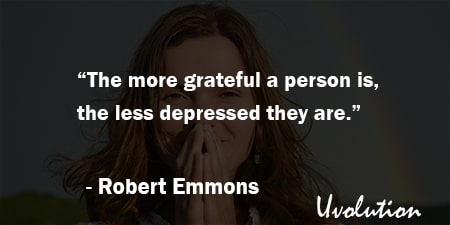Thanks by Robert Emmons
The Book in 1 Sentences
Thanks!: How Practicing Gratitude Can Make You Happier
“Gratitude has never, until recently, been examined or studied by scientific psychologists. It is possible that psychology has ignored gratitude because it appears, on the surface, to be a very obvious emotion, lacking in interesting complications: we receive a gift—from friends, from family, from God—and then we feel pleasurably grateful.
But while the emotion seemed simplistic even to me as I began my research, I soon discovered that gratitude is a deeper, more complex phenomenon that plays a critical role in human happiness. Gratitude is literally one of the few things that can measurably change peoples’ lives.” ~ Robert Emmons
5 BIG Ideas
1. Gratitude = 25% Happier + Better Sleep.
2. The more grateful a person is, the less depressed they are.
3. Some sort of suffering is also necessary for a person to achieve maximal psychological growth.
4. Gratefulness is not just a feeling. It is also an attitude.
5. keep a daily journal in which you record the blessings you are grateful for.
Thanks Book Summary
1. Why Do We Need “Happiness”?!
“So gratitude is a key to happiness, as I will argue from a scientific angle. And happiness itself is a good thing. An implicit assumption that many of us hold is that happiness depends on happenings—by what happens in our lives.
We believe that success in life—whether in the boardroom or the bedroom—makes people happier. Yet a recent review of the scientific literature on happiness revealed that happiness yields numerous rewards for the individual and precedes these outcomes.
This means that happiness makes good things happen. It actually promotes positive outcomes. The benefits of happiness include higher income and superior work outcomes (for example, greater productivity, higher quality of work, greater occupational attainment), larger social rewards (such as more satisfying and longer marriages, more friends, stronger social support, and richer social interactions), more activity, energy, and flow, and better physical health (for example, a bolstered immune system, lowered stress levels, and less pain), and even longer life.”
“The scientific literature suggests that happy individuals are also more creative, helpful, charitable, and self-confident, have better self-control, and show greater self-regulatory and coping abilities. Happy people, the facts clearly show, are flourishing and successful people.”
And also, in the great book The How of Happiness, Sonja Lyubomirsky says: “In sum, across all the domains of life, happiness appears to have numerous positive byproducts that few of us have taken the time to really understand.
In becoming happier, we not only boost experiences of joy, contentment, love, pride, and awe but also improve other aspects of our lives: our energy levels, our immune systems, our engagement with work and with other people, and our physical and mental health.
In becoming happier, we bolster as well our feelings of self-confidence and self-esteem; we come to believe that we are worthy human beings, deserving of respect.
A final and perhaps least appreciated plus is that if we become happier, we benefit not only ourselves but also our partners, families, communities, and even society at large.”
2. Gratitude = 25% Happier!
Emmons made a study with his team: Researchers split participants into three groups. Every week the participants kept a journal where they described, in a single sentence, five things they were either grateful for (the gratitude condition) or displeased about (the hassles condition). The neutral group simply described five events that happened (the events condition).
“What did the first study reveal? At the end of the ten weeks, we examined differences between the three groups on all of the well-being outcomes that we measured at the outset of the study.
Participants in the gratitude condition felt better about their lives as a whole and were more optimistic about the future than participants in either of the other control conditions.
To put it into numbers, according to the scale we used to calculate well-being, they were a full 25 percent happier than other participants.”
Not only that… In future studies, Emmons says that “participants in the gratitude condition felt more joyful, enthusiastic, interested, attentive, energetic, excited, determined, and strong than those in the hassles condition.”
So, it’s time to get a gratitude journal and start writing down what you’re grateful for….
3. Gratitude = Better Sleep!
“Compared to those who were not jotting down their blessings nightly, participants in the gratitude condition reported getting more hours of sleep each night, spending less time awake before falling asleep, and feeling more refreshed upon awakening.
Perhaps this is why grateful individuals feel more alive and vital during the day... This finding is enormous in that sleep disturbance and poor sleep quality have been identified as central indicators of poor overall well-being.”
“It may sound simplistic, but the evidence cannot be ignored: if you want to sleep more soundly, count blessings, not sheep.”
4. Practicing Gratitude in Relationships
“Recent research suggests that optimal mental health is associated with high ratios of positive to negative emotions. According to this model, normal functioning is characterized by ratios near 2.5 (that is, 2.5 times more positivity than negativity), whereas optimal functioning is characterized by ratios near 4.3.
Summarizing two decades of observational research on marriages, the University of Washington psychologist John Gottman, an expert in marital relations, concludes that unless a couple is able to maintain a high ratio of positive to negative affect (5:1 or greater), it is likely that their marriage will end.
In a highly publicized study, he and his colleagues observed 73 couples discussing an area of conflict in their relationship. The research team measured positivity and negativity using two coding schemes: one focused on positive and negative speech acts and another focused on observable positive and negative emotions.
Gottman reported that among marriages that last and that both partners find satisfying—what might be called flourishing relationships—mean positivity ratios were 5.1 for speech acts and 4.7 for observed emotions.
By contrast, among marriages identified as being on downward spirals toward dissolution the mean positivity ratios were 0.9 for speech acts and 0.7 for observed emotions.
Gottman has become so good at spotting the strengths and weaknesses of a marriage he can predict with 90 percent accuracy whether the marriage will end in divorce or not, often after just three minutes of observation in his marriage lab.”
5. Emotional Incompatibility
“The basic observation that positive emotions are somehow incompatible with negative emotions is not a new idea and has been demonstrated over several decades.
Back in the 1950s, this basic principle of emotional incompatibility provided the basis of behavioral therapies designed to treat phobias and other anxiety disorders.
One simply cannot be relaxed and stressed at the same time. Try it. You can’t.
Relaxation drives out anxiety and vice versa. The Buddha said that “Hatred cannot coexist with loving-kindness, and dissipates if supplanted with thoughts based on loving-kindness.”
You cannot be grateful and resentful at the same time, or forgiving and vengeful. When we are savoring the moment we cannot be regretting the past.”
“In several studies, depression has been shown to be strongly inversely related to gratitude. The more grateful a person is, the less depressed they are. The more depressed a person is, the less likely they are to go around feeling thankful for life.”
6. TV Commercials Vs Gratitude
“Here’s a frightening statistic: by the age of twenty-one, the average adult will have seen one million TV commercials. By playing on our desires and fears, these ads fabricate needs and cultivate ingratitude for what we have and who we are.”
7. Suffering = Growth
“It is relatively easy to feel grateful when good things are happening, and life is going the way we want it to. A much greater challenge is to be grateful when things are not going so well, and are not going the way we think they should.
Anger, bitterness, and resentment seem to be so much easier, so much more a natural reaction in times like these...
The religious traditions encourage us to do more than react with passivity and resignation to loss and crisis; they advise us to change our perspective, so that our suffering is transformed into an opportunity for growth.
Not only does the experience of tragedy give us an exceptional opportunity for growth, but some sort of suffering is also necessary for a person to achieve maximal psychological growth.
In his study of self-actualizers, the paragons of mental wellness, the famed humanistic psychologist Abraham Maslow noted that “the most important learning lessons... were tragedies, deaths, and trauma... which forced change in the life-outlook of the person and consequently in everything that he did.””
“It is gratitude that enables us to receive and it is gratitude that motivates us to repay by returning the goodness that we have been given. In short, it is gratitude that enables us to be fully human.”
8. Feeling Grateful Vs Being Grateful
“In thinking about the relations between suffering, gratitude, and growth, we need to remember the difference between feeling grateful and being grateful.
As a feeling, gratitude is a natural response to a particular situation when good things happen to an individual.
No one feels grateful when they have lost a job, received a devastating diagnosis, or seen their marriage crumble. How could they? It would be absurd and an insult to the person to suggest they should feel grateful in spite of what was happening to them...
But gratefulness is not just a feeling. It is also an attitude, a chosen posture toward life that says, “I will be grateful in all circumstances.”
Brother David Steindl-Rast, the world’s foremost teacher of gratitude, has written that “times that challenge us physically, emotionally, and spiritually may make it almost impossible for us to feel grateful. Yet, we can decide to live gratefully, courageously open to life in all its fullness. By living the gratefulness we don’t feel, we begin to feel the gratefulness we live.”
Conceiving of gratefulness as a posture toward life enables us to see how it can be tested and strengthened through adversity. Grateful feelings follow when good things happen; grateful attitudes precede goodness, and they precede trials. If one is not grateful before challenges arrive, it is going to be more difficult (though not impossible) to summon up gratitude after they hit.”
“Gratitude is not only an emotion, felt when receiving a benefit gladly, but it is also a stance toward life.”
9. Daily Gratitude Journal
“One of the best ways to cultivate gratitude is to establish a daily practice in which you remind yourself of the gifts, grace, benefits, and good things you enjoy.
One of the best ways to do this is keeping a daily journal in which you record the blessings you are grateful for. My research has shown... that this technique makes people happier.
When we are grateful, we affirm that a source of goodness exists in our lives. By writing each day, we magnify and expand upon these sources of goodness.
Setting aside time on a daily basis to recall moments of gratitude associated with even mundane or ordinary events, your personal attributes, or valued people in your life gives you the potential to interweave and thread together a sustainable life theme of gratefulness, just as it nourishes a fundamental life stance whose thrust is decidedly affirming.”
“It may be discouraging at first; sometimes your list will seem impoverished. Corroborating ancient wisdom, though, through research I have found that becoming aware of one’s blessings actually leads to having more to be grateful about.”
10. Emotional Contagion
“Internal strategies are good but not enough. We live in social contexts, and other people can facilitate or hinder our desire to become more grateful.
You might consider hanging out with grateful people and commit to spending less time with people who themselves lack this virtue. You may already do this, since ungrateful people, like chronic depressives, tend to be shunned.
A well-established social psychological law is the law of emotional contagion: an emotion expressed within a group has a ripple effect and becomes shared by the group’s members. People are susceptible to “catching” other people’s emotions.
... If we hang out with ungrateful people, we will “catch” one set of emotions; if we choose to associate with more grateful individuals, the influence will be in another direction.
Find a grateful person and spend more time with him or her. When you yourself express buoyant gratitude, you will find that people will want to “catch” your emotions.”
11. Go Through the Motion (Feelings follow behavior)
“So what if the motion has to be forced? The important thing is to do it. Do it now, and the feeling will come. There is a great deal of psychological evidence showing that attitude change often follows behavior change.
Good intentions are often crushed by old habits. If we stand around waiting for a feeling to move us, we may never get going. Get a person to perform a behavior, and, with some exceptions, their feelings will fall in line.”
“An ingenious series of experiments conducted a number of years ago showed that when people mimicked the facial expressions associated with happiness, they felt happier—even when they did not know they were moving “happy muscles” in their face. Researchers have found that smiling itself produces feelings of happiness.”
That was my QUICK Thanks Book Summary. If you’re interested, get your copy. There is a HUGE amount of wisdom and life-changing ideas in this book, and we’ve only touched on a tiny bit of it.
Buy The Book: Thanks by Robert Emmons

GET Blinkist 7 Days FREE Trial
3000+ Book Summaries
(Audio and Text)





